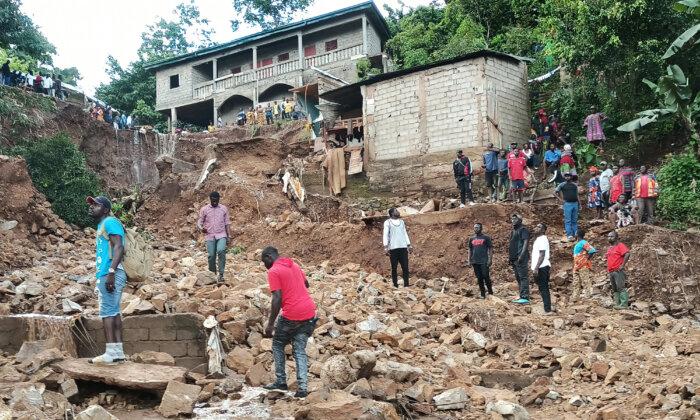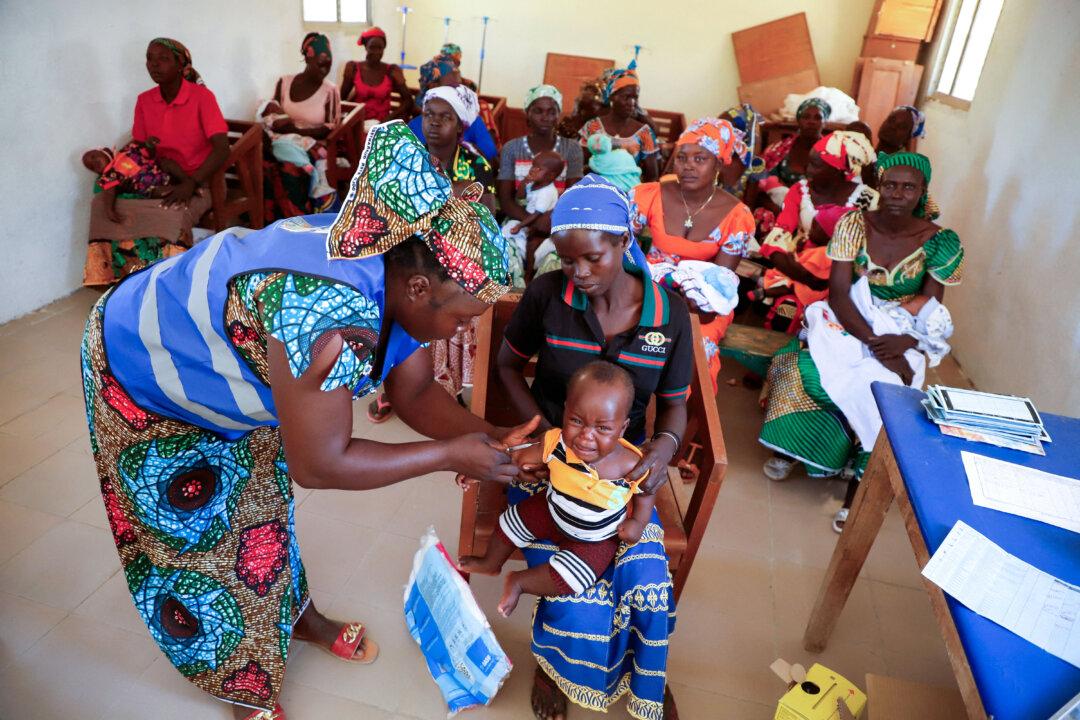A tree branch was all that Fabian Mebara had to hold on to as debris made patterns of mud in the water runoff that washed him from his house.
Mr. Mebara was using his phone in his dark room in Yaounde, on Oct. 8, when he heard a loud noise.
He went out to witness what was happening and instead was smashed into by the powerful water runoff that swept him more than 150 meters away.
“I fought hard to resist,” recollects the 49-year-old father of three.
The dam that gave way flushed its waters downstream, flattened Mr. Mebara’s house and left him with an eye injury.
“I have lost everything: TV set, pots, gas bottle, bed, telephone, money. All I have left is this dress on me. My children’s vital documents including birth and school certificates are all gone,” he tells The Epoch Times.
Prolonged and heavy rainfall caused a century-old levee holding back an artificial pond sitting on higher ground on the slopes of the Mbankolo hill— situated northwest of Cameroon’s capital city—to rupture.
The waters then carried along mud, rocks, and other dangerous materials, sweeping almost everything in their path, and causing huge human and property losses.
Despite everything, Mr. Mebara is a happy man. He is one among the few others who survived the tragedy that claimed more than 30 lives and injured scores of others.
Some residents claim not less than 100 perished in the disaster. More than 30 homes were destroyed, affecting 57 families.
“Thank God my children and my wife were not in the house the moment it happened,” he says. Unlike Mr. Mebara, another survivor, Yannick Tamgno Didero, wasn’t as lucky.
The 32-year-old lost most of his family members, including his 26-year-old pregnant wife. “I have lost my parents, my five-month pregnant wife, a brother, a niece, and a cousin,” he tells The Epoch Times.
“When I arrived in the neighborhood I heard screaming and pandemonium everywhere. We spent the whole night looking for bodies from the rubble and only found them kilometers away.”
Mr. Tamgno said four of his neighbors died while “many others are still unaccounted for.”
He also said he would have been a “dead man” today had he not gone out for a walk that Sunday. Devastated, Tamgno now relies on the “support” and “consolation” of friends and acquaintances to overcome the pain of losing loved ones.
“My only hope was to at least see my wife’s corpse. But it has not been found.”

Yaounde belongs to a vast group of high reliefs, made up of highlands and rounded mountain ranges. This creates a very contrasting landscape of valleys and swampy lowlands which fuel flooding.
The abundance and frequency of rainfall and the narrowness of the riverbed in the city are key drivers of floods.
As climate change worsens, a high variability of rainfall is increasingly observed in the bimodal rainforest zone of Cameroon, to which Yaounde belongs.
This is mainly characterized by abundant amounts of rain that fall during an increasingly short period of time, thus giving rise to heavy rainstorms.
In its periodic climate forecast and alert bulletin released on Oct. 1, the National Observatory on Climate Change (NOCC) in Cameroon, had predicted imminent floods in different parts of the country.
It specifically warned dwellers of the Centre region—where Yaounde is found—to watch out for possible “degradation or destruction of structures including bridges, culverts, embankments.”
While many residents apparently were not aware of the alert, those who did might have simply resigned to their fate with nowhere to run.

“This actually happened as predicted as floods affected a good number of localities in the city of Yaounde and its environs on the night of Sunday, Oct. 8,” Mr Patrick Forghab Mbomba, deputy director general of NOCC told The Epoch Times.
“The predicted torrential rains triggered a hydro geomorphological disaster on the flanks of the Mbankolo hill that same night,” he said, adding that deforestation exposed the area to heavy rains thereby triggering the disaster.
“This tragedy was preventable in the sense that some Cameroonian researchers and geographers already published some works as far back as 1988. And again just recently, they highly recommended that something had to be done to halt the deforestation of this area and continuous human settlement on the hillsides.”
On Nov.27, 2022, at least 15 people died in Damas, another neighborhood in Yaounde, following a landslide that the climate watchdog blamed on both human and natural factors.
Heavy rainfall that occurred over a relatively short period of time—compounded by ferritic soil with a clay texture—caused the tragedy.
“In this part of the capital, there are topographical differences sometimes reaching 11 meters between neighboring areas, as well as very steep slopes of around 60 degrees,” agreed Mr. Joseph Amougou Armathe, director general of NOCC.
At least 43 people also died during a landslide in the West region of Cameroon in 2019 after heavy rains swept away a dozen flimsy dwellings built on the side of a hill.

It may take years for survivors of the Mbankolo tragedy to come to terms with the loss of their loved ones—let alone pick up the broken pieces of their lives. Seventeen survivors are still recovering in hospitals. Some of them approached by The Epoch Times were too upset to speak.
Most of the victims initially admitted at the Oligha Deo Gracias Hospital situated near the disaster site, were later referred to the technologically advanced Yaounde Central Hospital due to the severity of the injuries.
“Most of the cases were trauma-related,” Dr Jules Njiki, Chief Medical Officer at the Oligha Deo Gracias Hospital, told The Epoch Times.
Dr Njiki said many victims came unconscious while others were “screaming with pains all over their bodies.
“Many were bleeding. Everybody was totally traumatized. We received countless ... victims which we later transferred to the Yaounde Central Hospital,” he said.
On Oct. 11, Cameroon’s Prime Minister Joseph Dion Ngute, chaired an inter-ministerial meeting to take stock of the damage caused by the disaster and to draw up a plan to assist victims.
Cameroon’s interior minister, Paul Atanga Nji, who attended the meeting, says the government is closely following up all the families affected by the tragedy.
“They have been given relief materials, while the hospitalized are being taken care of,” he said.
“We are trying to put in place a team to accompany the bereaved families and to give them assistance. We have the responsibility to accompany citizens in times of difficulty.”





